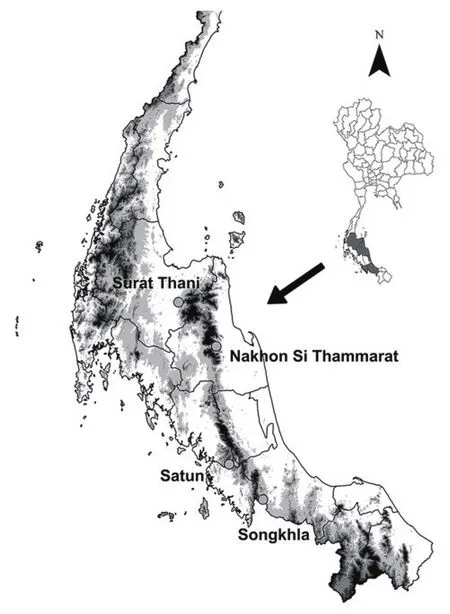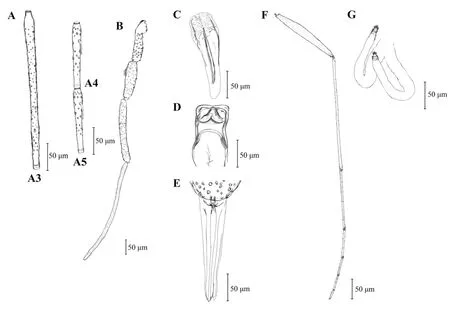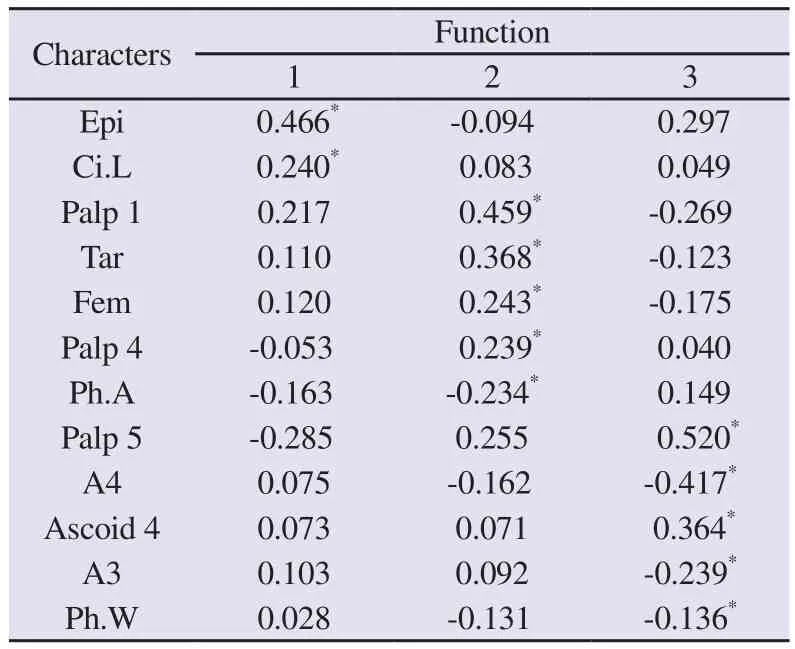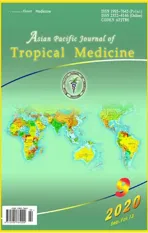Morphometric analysis of sand fly (Diptera:Psychodidae:Phlebotominae),Sergentomyia anodontis Quate and Fairchild, 1961, populations in caves of southern Thailand
2020-09-04NattapongManeerothNaweeNoonanantKanaphotThongkhaoTheerakamolPengsakul
Nattapong Maneeroth, Nawee Noonanant, Kanaphot Thongkhao, Theerakamol Pengsakul
1Department of Biology, Faculty of Science, Prince of Songkla University, Thailand
2Office of Disease Prevention and Control 11 Nakhon Si Thammarat, Thailand
3Faculty of Medical Technology, Prince of Songkla University, Thailand
ABSTRACT
KEYWORDS:Morphometric analysis; Leishmaniasis; Sergentomyia anodontis; Canonical discriminant analysis; Southern Thailand
1.Introduction
Sand flies are classified in the order Diptera Linnaeus, 1758,suborder Nematocera, family Psychodidae Newman, 1834, and subfamily Phlebotominae Rondani, 1840.There are three genera of sand flies:Phlebotomus Rondani and Berté, 1840, Lutzomyia França, 1924 and Sergentomyia França and Parrot, 1920, all of which suck the blood of vertebrates[1,2].Currently there are more than 700 species of sand flies, of which 70 species are able to transmit diseases to humans and animals[3].Sand flies are vectors of leishmaniasis, which is a disease caused by protozoa in the Leishmania group and can be transmitted from person to person,animal to animal and from animal to human[4].Previous studies have found that most cases of leishmaniasis in Thailand are caused by Leishmania martiniquensis, which is very common in southern Thailand[3,5,6].This area provides a suitable habitat for sand flies enjoying a tropical monsoon and rainforest climate with a long rainy season followed by a short dry season.The average temperature is 27 ℃-28 ℃ and the relative humidity is 81%-82%.The sand flies are found in cool, enclosed, moist, and shady places such as tree roots, rodent burrows, the rain-forest floor, animal shelters, termite mounds, vegetable matter, under stones and in caves which are one of the main habitats of sand flies[7,8].They live on the walls of caves,thriving in the humid conditions and feeding by sucking the blood of vertebrates in the caves[9].In a survey of the habitats of sand flies in Thailand, it was found that caves accommodate diverse species and have the highest abundance of sand flies compared to other habitats[10].Moreover, the largest number of patients who suffer from leishmaniasis are found in Surat Thani province[11], followed by Phang Nga[12], Trang[13], Songkhla[13]and Satun provinces[6],respectively.The high number of cases of leishmaniasis in southern Thailand suggests that the area has plentiful sand flies to transmit the disease.In addition, there have been reports of high numbers of sand flies over many years in southern Thailand, specifically in Surat Thani[10]and Chumphon provinces[9,14]although previous reports have not covered the entire southern region of Thailand.
In addition, Thailand has several national parks and wildlife sanctuaries and is currently developing its ecotourism potential including cave tourism[8,15].Therefore, this study focused on caves in southern Thailand.
Previous investigations of the diversity of sand flies have identified complex problems in the taxonomic classification of Sergentomyia (S.) bailyi (Sinton, 1931), since different species have similar morphological characteristics[16].In addition, there are also other groups within the same genus such as S.khawi,S.hivernus, S.gemmea and S.raynali that are similar.It may be confused with them[17].Some specimens from sibling species may have the same external characteristics, causing problems in the taxonomic identification of sand flies.Differentiating species based on their morphology requires expertise in classification and direct experience, which must be built up over a long period of time[18]and most classifications need to be based on a microscopic examination of the characteristics of the head and genitals[19,20].Another method to solve classification problems is the morphometric analysis of each species of sand fly[21-23].
In previous studies conducted in southern Thailand, 14 species of Sergemtomyia sand flies have been identified.S.anodontis, S.bailyi, S.barraudi, S.brevicaulis, S.dentata, S.gemmea, S.hodgsoni hodgsoni, S.indica, S.iyengari, S.perturbans, S.phasukae, S.punjabensis, S.quatei and S.sylvatica[24,25]and there have been several reports of S.anodontis, which is a species commonly found in limestone caves in Thailand[10,24,26].
The aim of this research was to study the morphological characteristics of various populations of S.anodontis sand flies in caves in the southern region of Thailand using morphometric analysis of the features of adult-stage flies.This report presents basic information relating to the taxonomic study of Sergemtomyia sand flies and develops the understanding of the taxonomy of sand flies in this genus in Thailand and Southeast Asia.
2.Materials and methods
2.1.Study design and sand fly collection
In this study, specimens were collected in four different locations in southern Thailand.The caves were situated in four provinces as illustrated in Figure 1, and the specimens were collected in Surat Thani (8°49'47.6" N, 99°22'44.0" E), Nakhon Si Thammarat(8°21'40.7" N, 99°47'06.4" E), Satun (7°05'39.3" N, 99°54'58.1" E)and Songkhla (6°42'55.6" N, 100°16'39.6" E) provinces.Previous studies have collected sand flies each month in caves in Thailand,and found increased numbers during the early rainy season (June-August)[26].This study was conducted between February and December 2017.The sand flies were collected in Center for Disease Control (CDC) light traps (John W.Hock Co.Florida, U.S.A.) during the night between 6 p.m.and 6 a.m.The method for collecting and preparing specimens in this study was certified by the Institutional Animal Care and Use Committee, Prince of Songkla University,under reference number 2561-10-021.

Figure 1.Map of southern Thailand showing the localities where the specimens were collected in Surat Thani, Nakhon Si Thammarat, Satun and Songkhla provinces.
2.2.Sample preparation
From a total of 651 specimens captured, 107 female S.anodontis sand flies were isolated and sacrificed in 95% ethanol, then mounted on glass slides.The specimens were prepared for examination by the application of a drop of Hoyer's medium (15 g gum arabic, 100 g CCl3CH(OH)2, 25 mL H2O and 10 mL C3H8O3)[27], and the head was cut from the body.The head was then arranged facing upwards and the species was identified using the type taxonomic keys of Lewis (1979)[28], Lane and Crosskey (1993)[29], and Abonnenc(1972)[30].The identification of the specimens was confirmed by the Communicable Disease Surveillance Department of the Office of Disease Control 11 in Nakhon Si Thammarat province and the Office of Disease Control 12, Songkhla province.The specimens were photographed using an Olympus DP21 camera (Olympus Corp.,Tokyo, Japan) connected to an Olympus CX31 RBSFA microscope(Olympus Corp., Tokyo, Japan) with a size scale on the picture.The samples were then measured to study their morphology.
2.3.Morphometric study
Measurements were conducted with the size of traditional morphological characteristics used to identify species of sand fly.The morphological characteristics used were antennal segment 3(A3), antennal segment 4 (A4), antennal segment 5 (A5), ascoid on antennal segment 4 (Ascoid 4), ascoid on antennal segment 5(Ascoid 5), epipharynx (Epi), palpal segment 1 (Palp 1), palpal segment 2 (Palp 2), palpal segment 3 (Palp 3), palpal segment 4(Palp 4), palpal segment 5 (Palp 5), pharynx length (Ph.L), pharynx width (Ph.W), pharynx armature (Ph.A), cibarium length (Ci.L),cibarium width (Ci.W), femur on hindleg (Fem), tibia on hindleg(Tib), tarsal segment 1 on hindleg (Tar.1), tarsus on hindleg (Tar),spermathecae length (Sperm.L), spermathecae width (Sperm.W),and head of spermathecae length (Sperm.Hea), as shown in Table 1 and Figure 2.
The morphological characteristics with a significant normal distribution (P>0.05) were A3, A4, Ascoid 4, Epi, Palp 1, Palp 2,Palp 4, Palp 5, Ph.W, Ph.A, Ci.L, Fem, and Tar.1.The homogeneity of variance tested by Levene's test showed that the morphological characteristics with homogeneous variance were A3, A4, A5, Ascoid 4, Ascoid 5, Epi, Palp 1, Palp 3, Palp 4, Palp 5, Ph.L, Ph.W, Ph.A,Ci.L, Ci.W, Fem, Tib, Tar.1, and Sperm.W.
2.4.Statistical analysis
The data were checked to confirm the normality of their distribution and the homogeneity of their variance using the Kolmogorov-Smirnov test and Levene's test.If the hypotheses of normality and homogeneity of the data were confirmed, ANOVA was used to check for statistically significant differences, but if those hypotheses were not supported, the Kruskal-Wallis test was used[31].In addition,since Levene's test does not consider covariance, Box's M test was used to test the multivariate assumption of the equality of the covariance matrices.After checking the data, they were analyzed using canonical discriminant analysis (CDA).A graph was created from the canonical discriminant score and the canonical discriminant function was determined to group the results.The significance of the discriminant function was estimated using Wilk's lambda based on the chi-square statistic.The propriety of the analysis was evaluated by the leave-one-out validation method, in which the data was successively re-grouped leaving out one specimen and the identification of that specimen was then based on the remaining grouped data.All the analyses were conducted using IBM SPSS Statistics Base 23.0.
3.Results
3.1.Morphometric study
The results of the morphometric measurement of 107 S.anodontis sand flies determined as previously described are shown in Table 1.The average and standard deviations of each morphological feature analysed are shown in Table 2.

Table 1.List of morphological characteristics and description of feature measurements conducted on Sergentomyia anodontis.

Figure 2.Morphological characteristics of Sergentomyia anodontis females.A:antennal segment 3-5; B:palpal segment 1-5; C:pharynx; D:cibarium; E:epipharynx; F:hindleg; G:spermathecae.

Table 2.Mean and standard deviation of morphometric measurements (µm) of female Sergentomyia anodontis sand flies collected from 4 locations in southern Thailand.
3.2.Pre-test for morphometric analysis
For the characteristics which were found to be normally distributed and for which the assumption of homogeneity of variance was satisfied, one-way ANOVAs on the measurements of the S.anodontis samples showed significant differences among the populations from the four study sites in a total of 11 morphological features(Table 2).Differences among the populations from four study sites were found in respect of A3, A4, Ascoid4, Epi, Palp1, Palp4, Palp5,Ph.A, Ci.L, Fem and Tar.However, the other 12 characteristics were not normally distributed, nor was their variance homogeneous and differences were therefore determined using the Kruskal-Wallis test, based on which there were significant differences between the populations from the four sites in a total of 10 characteristics, A5,Ascoid5, Palp2, Palp3, Ph.L, Ci.W, Tib, Tar.1, Sperm.L and Sperm.Hea (Table 2).This study found that the morphological features of the female specimens of S.anodontis, from Surat Thani, tended to be larger than the samples from the other areas, including Epi and A4.Palp 5 and Sperm.L were smaller than those of the specimens from other areas, while the ascoid 4, Ph.W, Fem, Tar and spermathecae lengths did not differ among the S.anodontis from the four areas based on the Scheffe post-hoc test (P<0.05).
3.3.Morphometric analysis
When the significant differences in multivariate data relating to morphology are identified under CDA, Box's M testing is important,since it can indicate potential problems and ensures the covariance matrix does not affect the overall result of the analysis.In this study the M test produced a value of M=354.777 which was significant at P<0.001.The outcome of the analysis resulted in three classification functions.The morphological characteristics, Epi, Ci.L, Palp 1, Tar,Fem, Palp 4 and Ph.A were the main characteristics classified which differed among the four areas studied as can be observed from the structure matrix (Table 3).The first function, which accounted for 60.8% of the variance (Wilk's Lambda=0.105, chi-square=162.54,df=36, P<0.001), separated the S.anodontis population in Surat Thani province from those of the other areas.Meanwhile, the second function, which accounted for 21.8% of the variance, distinguished the population from Songkhla province from those of the other areas.From the classification results shown in Table 4, based on an analysis of 81 specimens, the group classification equation was correct in 87.7% of cases.
In the scatter chart of discriminant scores from the two functions,sand fly populations from Nakhon Si Thammarat, Satun and Songkhla provinces can be seen to be closely related, while the population in Surat Thani province shows considerable differences from those in the other three provinces (Figure 3).The results show that the features of the external and internal morphology of S.anodontis sand flies with high variation are A3, A4, Ascoid4,Epi, Palp1, Palp4, Palp5, Ph.A, Ci.L, Fem and Tar, while other morphology features, such as the widths of the pharynx and the spermathecae have low variation.The sand flies in Surat Thani province were found to have differences in their morphology from the populations in other areas, including Epi, A4, Palp 5 and Sperm.L.Therefore, based on the CDA data, the populations from Nakhon Si Thammarat, Satun and Songkhla province are closely related while the population from Surat Thani province is distinct from those of the other three provinces (Figure 3).

Table 3.Structure matrix of morphometric characteristics selected by canonical discriminant analysis to differentiate female Sergemtomyia anodontis, collected from Surat Thani, Nakhon Si Thammarat, Songkhla and Satun provinces in southern Thailand.

Figure 3.Scatter plot of canonical discriminant functions derived from measured characteristics of Sergentomyia anodontis, collected from Surat Thani (SN), Nakhon Si Thammarat (NK), Songkhla (SK) and Satun (ST)provinces in southern Thailand.

Table 4.Leave-one-out cross validation for all specimens used in the discriminant analysis of morphometric measurements of Sergemtomyia anodontis,collected from 4 locations in southern Thailand.
4.Discussion
From the study of the external and internal morphology of the S.anodontis sand flies collected from four caves in Surat Thani, Nakhon Si Thammarat, Satun and Songkhla provinces,the morphological characteristics with high variance were A3,A4, Ascoid4, Epi, Palp1, Palp4, Palp5, Ph.A, Ci.L, Fem and Tar,while those with low variance were the widths of the pharynx and spermathecae.The morphological features showing high and low variation may be the result of changes in the morphology of the sand flies in each population, due to the nature of the habitats in which they live, such as food accessibility, environmental conditions, and selective pressures[32].It can be stated that caves with more resources offer more biological complexity than caves with fewer resources.In addition, most of the differences between the four populations occurred in the lengths of palp 5, the spermathecae, antennal segment 4 and the epipharynx.These differences may involve factors such as climate and the local ecology, which may indicate directional selection or genetic drift, especially in Surat Thani's population.
It has been suggested in previous studies that the flight distance of adult sand flies is short and usually limited to the area in which larval development occurs[33], and that sand flies have poor flying ability and that their range has a spread of no more than 100 m[34],Therefore, it may be assumed that sand flies have only limited populations within each local area and that genetic differences may arise not only between species but also between populations of the same species of sand fly in different areas[35].When all the morphological differences based on the canonical discriminant functions are considered, the population in Surat Thani province must be grouped separately from those in Nakhon Si Thammarat,Satun and Songkhla provinces.This separation may be due to the geography of the caves in different areas, both in their physical and biological attributes, including environmental factors, precipitation,temperature, physical barriers, altitude, latitude, habitat availability and the distribution and abundance of vertebrate hosts[36].Differences in the height above sea level in each cave may result in variation in the morphology of sand flies.The heights above sea level of the caves in Surat Thani, Nakhon Si Thammarat, Satun and Songkhla provinces were 201 m, 145 m, 88 m and 103 m, respectively.The cave in Surat Thani province is, therefore at the highest altitude,which may cause the morphology of the sand flies to change and the characteristics of the populations in each area to vary.Belen(2004) [35]found that populations at elevations of 1 117 m and 488 m were distinctly different based on the measurement of morphological characteristics and it has also been found that variation between populations appears at an altitude range of 800-1 000 m[37].In past studies of geographically distinct populations of S.hodgsoni hodgsoni sand flies in Thailand, changes were found within the same species in relation to wing morphology between different geographic areas but there were no differences in sand flies between species[38].There is therefore a tendency for different species to evolve in the same direction, when each species is subjected to the same environment and geography, resulting in similar variations in morphology.
Morphological characteristics such as the width of the posterior part of the pharynx and the spermathecae showed low variation in the populations of S.anodontis sand flies investigated.Based on the appearance of antennal segment 3 and its ascoid, and the pharynx,different species of Phlebotomus (P.) argentipes, P.annandalei and P.glaucus, which are groups occupying similar habitats and with similar external morphology, are difficult to distinguish[39].The results of this study found some variability in the pharynx, making it possible to use this morphological feature to classify sand flies.In addition, the characteristics of the ascoid have been used in the classification of S.bailyi, of which two species have been classified,which have been denoted as S.bailyi species A and B, depending on the relative length of their ascoid[17].Traditional morphometrics remains a useful tool for the classification and characterization of populations within each species.It is also more cost-effective than more expensive molecular studies[40].In this study, it was found that the morphological characteristics of the populations varied and it was also demonstrated that the overall differences in morphology chosen by the canonical discriminant functions, indicated that the population in Surat Thani province is separate from the populations in Nakhon Si Thammarat, Satun and Songkhla provinces.To the best of our knowledge, this is the report of S.anodontis sand flies that involves the determination of internal and external morphology using morphometric analysis from caves in southern Thailand.Comparison of the morphology of sand flies may be useful for the identification of similar species or changes in the population of sand flies in field collection and may play a role in monitoring sand fly populations in relation to controlling and preventing leishmaniasis.
Conflict of interest statement
The authors declare that there are no conflicts of interest.
Acknowledgements
We would like to thank the Department of Biology, Faculty of Science, Prince of Songkla University and the Communicable Disease Surveillance Department of the Office of Disease Control 11 in Nakhon Si Thammarat province and the Office of Disease Control 12, Songkhla province.The authors would also like to thank the Faculty, of Medical Technology, Prince of Songkla University for supporting this research.
Funding
This work was supported by the Faculty of Science Research Fund, Prince of Songkla University, Contract No.1-2559-02-012 and supported by the Prince of Songkla University, Contract No.MET610469S.
Authors' contributions
T.P.and N.M.are engaged in research plan, design and research conduct, data collection, data analysis, research findings summary,reports writing and articles preparedness for publication.N.N.and K.T.are involved in conducting research and data analysis.All authors contributed to the final version of the manuscript.
杂志排行
Asian Pacific Journal of Tropical Medicine的其它文章
- Larvicidal efficacy of plant extracts and isolated compounds from Annonaceae and Piperaceae against Aedes aegypti and Aedes albopictus
- Treatment for COVID-19 patients in Vietnam:Analysis of time-to-recovery
- Knowledge of coronavirus disease 2019 (COVID-19) among healthcare providers:A cross-sectional study in Indonesia
- Soil-transmitted helminth egg contamination from soil of indigenous communities in selected barangays in Tigaon, Camarines Sur, Philippines
- Performance and correlation of QuantiFERON-TB Gold, T-SPOT.TB and tuberculin skin test in young children with or exposed to tuberculosis
- Lymphopenia as a marker for disease severity in COVID-19 patients:A metaanalysis
